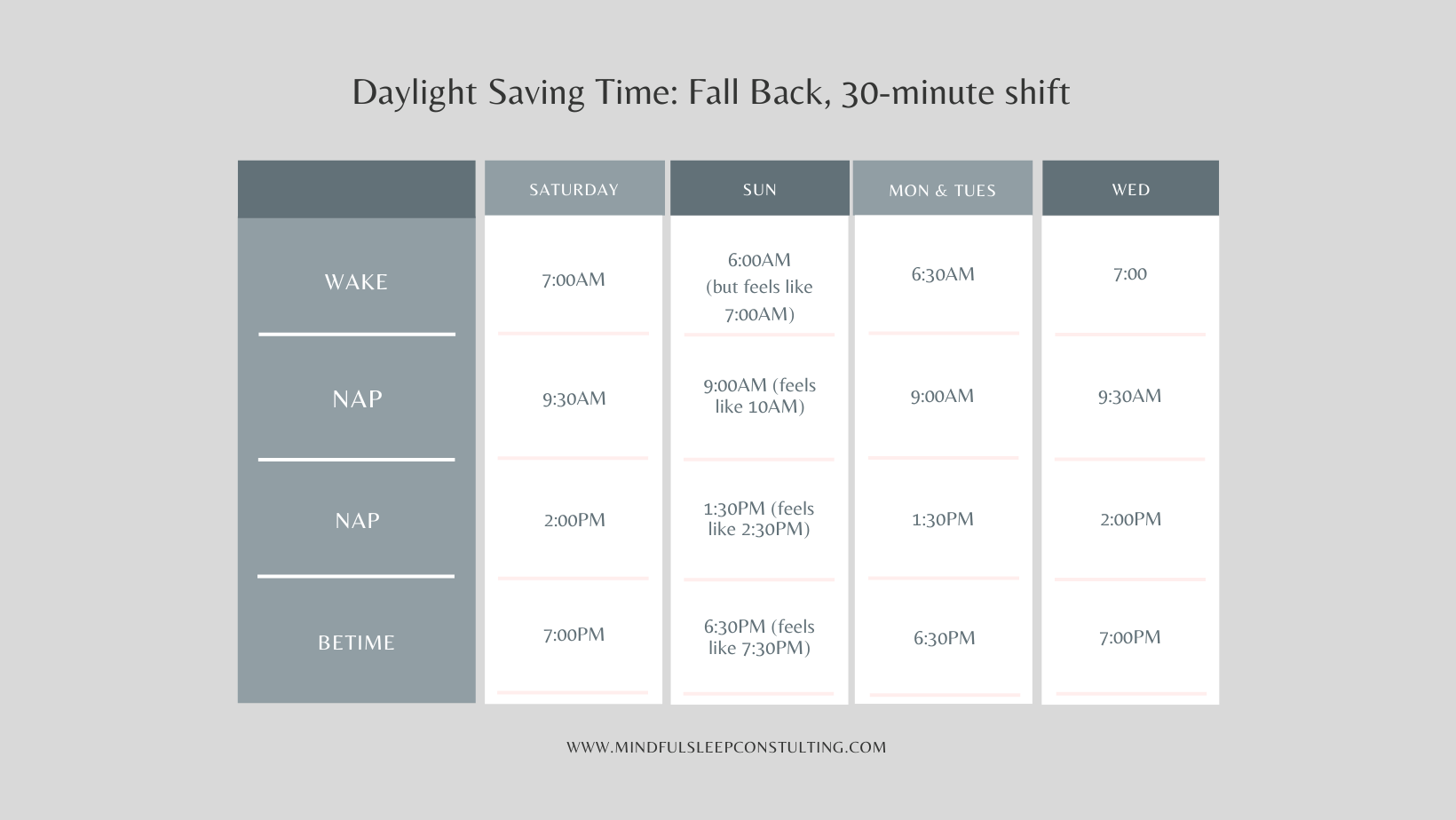How to Adjust Your Child’s Schedule for Daylight Saving Time: Fall Back
It’s fall! That means plaid, pumpkin spice lattes, Halloween and… Daylight Saving Time.
*cue spooky music playing in the background*
As a parent, Daylight Saving Time can be somewhat scary-but it doesn’t have to be! With some simple adjustments, everyone can adjust fairly quickly. But HOW to adjust your child’s schedule is the big question on everyone’s mind, right?! In this blog, I’ll go over your options!
Option 1: Do nothing
If your little one is still on that summer schedule and you’ve been looking to move it back, then you don’t need to do anything for Fall Back!
Here’s a sample of a two nap schedule after the time change.
Option 2: Small adjustments.
Newborns: Starting on Tuesday before the time change, shift your newborn’s day later by 10 minutes each day. You won’t be adjusting their wake windows, just their morning wake time. So if you normally wake them up at 7:00am, then you will wake them at 7:10am on Tuesday, 7:20am on Wednesday and so on.
What’s the ideal schedule for your newborn?
Wake up: between 6:00-7:00AM
Awake window: 45-60 min then down for nap, repeat until bedtime.
What’s the ideal bedtime for your newborn?
0-6 weeks: 8:00-10:00pm
6-15 weeks: 7:00-9:00pm
Infants: For your 4-5 month olds, you can adjust their schedule in bigger increments, such as 15-30 minutes. If their normal wake time is 7:00am, wake them 15 mounts later each day. You will still follow awake windows at this age.
What’s the ideal schedule for your 4-5 month old?
Wake up: between 6:00-7:00am.
4 months: awake window 1.5 hours then down for nap, repeat until bedtime.
5 months: awake window 2-2.5 hours then down for nap, repeat until bedtime.
What’s the ideal bedtime for your 4-5 month old?
7:00-8:00pm
For the 30-minute adjustment
Option 3: Adjust the weekend of.
First step, get some coffee or tea. Second step, adjust clocks. No need to rush in to changing the clocks, just try to enjoy the morning first!
I like this adjustment option for babies six months and older.
On Sunday, if your child normally wakes at 7:00am, wake up time will be 6:00am (but will feel like 7:00am). Adjust their nap schedule by 30 minutes.
Ex: If nap 1 is normally at 9:30am it is now 9:00am. This will feel like 10:00am, so expect your little one to be a little bit tired. Follow this adjustment for 3-4 days before moving their schedule the remaining 30 minutes. Pin the guide below to your Pinterest to have on hand for when Daylight Saving Time comes!
Important Factors to Keep in Mind
Maintain your child’s bedtime routine.
The bedtime routine plays an important part in preparing your child for sleep. These steps help cue to their body that sleep is coming! You’ll want to continue doing the same bedtime routine throughout the time change adjustment.
The routine doesn’t need to be complicated.
Feed
Bath/clean up
Brush teeth/gums
Diaper, pjs, sleep sack
Stories and snuggles
Lights out
Use light and darkness to your advantage.
During your baby’s awake times, expose them to daylight! Play by a window, get out for a walk or play in the leaves. If it’s a cloudy or rainy day, turn on all the lights in your house. The early daytime exposure to light will help their body produce melatonin, the sleep hormone, for sleep that night. Light in the afternoon and evening can also help your baby to keep awake until bedtime.
As you approach nap time or bedtime, start to dim the lights or come back inside to a darker environment. Be sure to turn off all lights and close curtains and blinds as you lay them down for sleep. Ideally, you want their sleep space to be pitch black until it’s time to start their day or wake them from nap. Even the tiniest bit of light seeping through the window can cause them to stay awake.
If you are needing some help with darkening your baby’s sleep space, check out my blog on the Best Blackout Solutions!
Change takes time.
Remember, change can take time. With Daylight Saving Time, you are shifting your child’s schedule and adjusting their circadian rhythm. This process can take a couple weeks for your baby to adjust to. If your little one is still struggling after a few weeks, you can always reach out for help here!
If you’re reading this and struggling with your baby’s sleep, you don’t have to wait until you reach your breaking point with sleep deprivation to ask for help (like myself and so many others have!).
I offer free 30-minute calls to see if working together would be a good fit. I am here to be your go-to person, to answer your questions and support you, making the sleep training process easier on the whole family!
Sleep easy,
Yasmin Johnston
Your Pediatric Sleep Consultant





